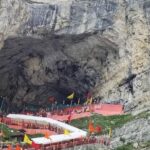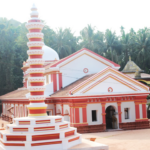Bhimashankar Temple is an ancient shrine, one of the twelve Jyotirlingas of Shiva in India. It is located in the Sahyadri hills of Maharashtra, near Pune, and is a significant pilgrimage site for Hindus. The temple is nestled in a lush green forest, which is now part of the Bhimashankar Wildlife Sanctuary.
Mythological Background
The temple is deeply rooted in Hindu mythology, particularly in stories related to Lord Shiva. The legend goes that Bhimashankar is associated with the demon Bhimashura. According to mythology, Bhimashura was the son of Kumbhakarna (the brother of the demon king Ravana). After intense penance, Bhimashura received a boon from Lord Brahma, granting him invincibility. Drunk with power, he terrorized the gods and people on earth. The gods, helpless, prayed to Lord Shiva for help. Shiva descended in his fiercest form and destroyed Bhimashura in a great battle. Post-victory, the gods requested Shiva to reside in the form of a Jyotirlinga at Bhimashankar to protect the region from evil forces.
This is believed to be the origin of the Bhimashankar Jyotirlinga, symbolizing Shiva’s protective and compassionate nature. The river Bhima, which originates near the temple, is also believed to have been formed from the sweat of Lord Shiva after the battle with the demon.
Historical and Architectural Significance
- Temple Structure: The Bhimashankar temple showcases a blend of Nagara style architecture. The temple has intricate stone carvings and represents a mix of old and modern architecture, with portions of the structure having been renovated in more recent times.
- Maratha Influence: The temple is said to have received significant patronage from the Maratha rulers. One of the key contributors was Nana Phadnavis, an influential minister in the Peshwa era, who helped in reconstructing parts of the temple during the 18th century.
Spiritual Significance
As one of the 12 Jyotirlingas, Bhimashankar holds great importance in the Shaiva tradition. Pilgrims from all over India visit this temple to worship Lord Shiva and seek his blessings. The Jyotirlinga represents the infinite, radiant nature of Lord Shiva, who is worshipped as the Supreme Being.
- Jyotirlinga Legend: The 12 Jyotirlingas are believed to be self-manifested forms of Shiva, not sculpted by human hands. The Bhimashankar Jyotirlinga is revered as the 6th of the 12.
Bhimashankar Wildlife Sanctuary
Established in 1985, the sanctuary around the temple is home to rich biodiversity. The Maharashtra Forest Department set it up to protect endangered species like the Indian Giant Squirrel (Shekru), which is the state animal of Maharashtra. The sanctuary is spread over approximately 131 square kilometers and is a favorite destination for nature enthusiasts, bird watchers, and trekkers.
- Flora and Fauna: Apart from the Indian Giant Squirrel, the sanctuary has a variety of flora and fauna, including leopards, sambar deer, and many species of birds and butterflies.
Trekking and Tourism
Bhimashankar is also popular for its trekking trails. The natural beauty of the Sahyadri hills makes it a favorite destination for adventure enthusiasts and nature lovers. The trek to the temple is often filled with scenic views, dense forests, and waterfalls, especially during the monsoon season.
Festivals
- Maha Shivaratri: The biggest festival at Bhimashankar is Maha Shivaratri, a day dedicated to Lord Shiva. Thousands of devotees visit the temple to offer prayers and participate in the grand celebrations.
- Kartik Purnima: Another important festival is Kartik Purnima, which falls in November or December. This marks the day Lord Shiva defeated the demon Tripurasura, and a grand procession is held at the temple.
Access
- By Road: Bhimashankar is well-connected by road from Pune (around 110 km) and Mumbai (around 220 km). Several buses and taxis ply to the temple.
- By Rail: The nearest railway station is Pune Railway Station, from where one can take a road journey to Bhimashankar.
- By Air: The nearest airport is Pune International Airport.













